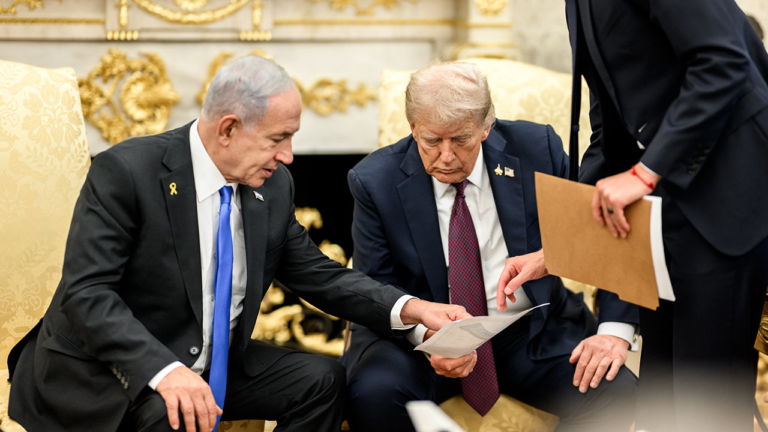Theatre in Anchorage: How the Alaska Summit Proposed Ukraine’s Future
The Trump-Putin summit in Alaska, Putin’s first U.S. visit since 2022, shifted American policy toward Moscow’s terms by framing territorial concessions as “peace,” raising fears that Ukraine could face a partitioned, quasi-occupied future akin to the West Bank.
On 15 August 2025, U.S. President Donald Trump hosted Russian President Vladimir Putin at Joint Base Elmendorf-Richardson in Anchorage, Alaska. This visit marked Vladimir Putin’s first appearance on American soil since launching the 2022 invasion of Ukraine. Thus, providing the coverage of the Alaska summit an air of theatricality. The details: the summit was hosted in Anchorage’s Joint Base Elmendorf-Richardson. Features included: a carefully rolled red carpet stretched across tarmac, a 21-gun salute and fighter jets that roared overhead in choreographed flyovers. These symbolic gestures were designed to project strength and ceremony, but to many observers, they bedizened the emptiness of the proceedings.
Commentators noted that while the summit delivered a flood of striking pictures, handshakes before flags, honour guards and aesthetics – the substance of the talks appeared thin, even evasive. For Russia, the spectacle of the summit delivered a form of international reintegration after years of sanctions and partial isolation. For the United States, the summit projected an image of diplomatic agency at minimal material expense. Simply: For Putin, the grandeur provided international validation after years of isolation. For Trump, it offered optics of statesmanship without the burden of diplomatic commitments.
At the close of the summit, President Trump had withdrawn from his earlier insistence on an immediate ceasefire, opting instead for the broader pursuit of what was called a “comprehensive peace agreement.” This formulation appeared more congruent with Moscow’s diplomatic vocabulary and observers quickly interpreted the American shift as more than simply a linguistic recalibration. The distinction, subtle in rhetoric, is profound in consequence. To insist on ceasefire first is to halt aggression before dialogue; to chase comprehensive peace is to allow aggression to set the terms of dialogue. It reflected a reorientation of U.S. negotiating posture – from treating the invasion as an outright violation of sovereignty requiring reversal, toward recognising it as a political dispute to be settled through transactional compromise. This subtle reframing points to the familiar logic of hegemonic diplomacy. The adjustment mirrors Moscow’s long-standing line and accentuates how populist political priorities are shaped not only by questions of security, but by the domestic political economy of foreign policy, whereby Trump’s symbolic achievements and the performance of his leadership takes precedence over the material commitments of sustaining prolonged resistance.
For Putin, this framing created the opportunity to repackage his territorial demands as pragmatic bargaining chips. In his remarks following the summit, he called for Ukraine to formally relinquish the Donetsk and Luhansk regions, which have been under Russian occupation since 2014. In return, Putin floated the idea of a “freeze” along the current front lines in other embattled provinces, including Kherson and Zaporizhzhia. The logic of the proposals was unambiguous: Russia would cement its hold over the Donbas region, while the U.S. could present the arrangement as a stabilising “armistice” across other contested regions. Such a formulation, though framed in the language of peace, functioned less as resolution than as a codification of territorial conquest, institutionalising the asymmetry of force that had produced it.
Expectedly, the response from Kyiv and other European capitals was swift and defiant. President Volodymyr Zelensky and other European leaders reiterated that no territorial concession could ever be legitimised without Ukraine’s explicit consent. To do so, they warned, would not only betray Ukrainian sovereignty but also corrode the foundations of international law – undermining the Helsinki Final Act (and the United Nations Charter Article 2.4, as well as the UN General Assembly Resolution 2625) that borders cannot be changed by force. Some have warned rewarding territorial conquest under the guise of “peace” would embolden other powers, creating dangerous precedents far beyond Eastern Europe.
Thus, what Trump framed as a pragmatic recalibration toward peace was widely seen across Europe as a perilous alignment with Moscow, freezing the war on Russia’s terms and enshrining territorial gains against Ukraine.
Reports are now suggesting that the summit discussions evoked models resembling an occupation-based partition, reminiscent to the West Bank, where Israel’s continued control has created de facto annexation over contested territories. The analogy is not accidental: it signals a diplomatic template in which territorial seizure is gradually normalised through time, administration and international fatigue, rather than reversed.
While precise details of any prospective arrangement remain unclear, the analogy carries a significant weight. It raises the idea of Ukraine being reconstituted as a fragmented geopolitical entity, in which certain regions fall under Russian authority while the remainder exists in a state of unstable sovereignty, reliant on external guarantees but deprived of complete autonomy. An outcome like this would not only corrode the principle of territorial integrity at the heart of international law but entrench a hierarchy of direct hegemonic domination in Europe.
From a structuralised perspective, this form of partition reflects more than localised military realities. It embodies the political economy of imperialism, where hegemonic powers negotiate the division of space and authority with no regard for the agency of populations in those territories. Just as the West Bank became a theatre for the reproduction of asymmetric control, sustained by military force and international acquiescence, Ukraine risks becoming the site of a similar “frozen conflict” institutionalised through external mediation.
For Kyiv, the implications are stark. Accepting this model would not deliver peace, but rather perpetuate insecurity, a state where Ukraine is indefinitely suspended between sovereignty and subordination.



